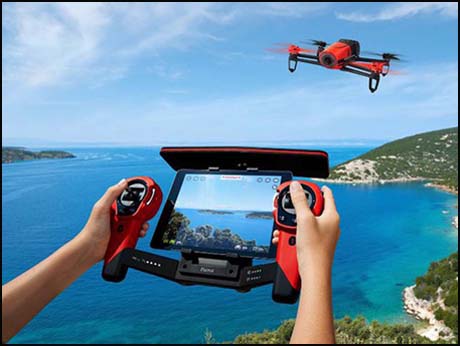
Remotely controlled micro drones have become serious consumer products with many interesting applications which are perfectly legal in India....
By Anand Parthasarathy
February 17 2015: The micro-drone is an idea whose time has come. We are not talking about the big military unmanned vehicle with a bomb in the nose that some governments have been deploying to take out their enemies on foreign soil.
No, the biggest personal technology of idea in 2015, will likely be a small rubber-and-plastic contraption, weighing less than 1 kg, the size of a large pizza. It is more accurately called a quadcopter because it is lifted and propelled by four rotors, two of them spinning one way and two the other. Vary the speed of the rotors and you can control how the drone pitches, yaws, climbs, descends or zooms. The beauty of this new class of drone is that the personal controlling it is YOU , working with a smart phone or tablet.
Like all compelling personal technologies, the micro drone won't go away just because governments worldwide are worried about what drones in public hands can do.
We first heard of personal drones about a year ago when they were tried out worldwide, to deliver pizzas. In May last year, Francesco's Pizzeria, in Mumbai's Lower Parel area, did a test delivery to the 21st floor terrace of an apartment in Worli about 1 1/2 kms away. The police made threatening noises -- so the idea never took off.
As things stand, it is unlikely that in India, authorities will allow the use of drones in public spaces any time soon. The Director General of Civil Aviation took the easy option of banning drones altogether, presumably, till government figures out what is the legislation elsewhere. In countries where some form of regulation is in place, recreational drones are generally permitted if the height flown is less than 400 feet ( 120 metres) and the range is within line of sight or not more than half a kilometre. There are also restrictions if you strap a camera to the drone ( the most common use today): you can't breach other people's privacy or get closer than 30 metres to them.
In the absence of any regulation in India on use of drones in public space, it is better to deploy drones within one's private property -- and even this offers a lot of interesting options:
There is no difficulty in using drones indoors -- and at many weddings these days, it makes for more interesting video, if the camera is mounted on a drone rather than on a Jimmy Jib crane which costs around Rs 7000/ hour to hire. A drone with a gyro-stabilised fish eye lens and a full HD camera can be had in India for around Rs 30,000. Indeed, at the last three mobile phone launches I have attended, the handset was delivered to the VIP on the stage by a drone. These payload drones which can carry about 500 grams, cost between Rs 10,000 - 15,000.
Within gated communities or large apartment complexes, there should be no problem in operating drones within the private space -- and the labour-saving possibilities are endless. If a courier consignment -- or a pizza for that matter -- is handed over at the security gate of the complex, it can very well be flown to the balcony of a 10th floor apartment rather than have a delivery person walk a a few hundred metres and take the elevator!
I heard informally that some resort hotels in Goa are also toying with the idea of using drones to deliver a newspaper or housekeeping extras like tea bags or towel, to guests in distant sea-facing cottages.
And what about the campuses of the big IT companies? The Microsoft campus in Gachibowli, Hyderabad is so vast, it can take 10 minutes to reach some departments from the main gate. Some of their staff who had visited the US had brought toy drone kits for their kids to assemble and I heard some loud talk about how easy it would be distribute mail daily via drone, to each department.
Even a country with strict air space controls like China, has permitted e-commerce giant Alibaba to deliver ginger tea packets to customers in some areas of Beijing and Shanghai, via drone. Even three years ago, some academic campuses like the Free University of Berlin realised that drones were an unstoppable idea and permitted them on campus for food delivery, albeit in a controlled way. In the world's vast out doors, some breathtaking views of nature otherwise unobtainable, are being captured -- using camera-drones. Film makers will soon make a drone yet another platform for their movie cameras.
Will the personal drone will be as common as the personal phone or computer? Maybe not; but the possibilities are truly exciting. And as it happens with phones, your children will learn to use one creatively, before you do! The cheapest drones cost just Rs 3000 or so at Indian online shops -- so start flying!
For a survey of Made in India drones please our Image of the Day Section on the home page